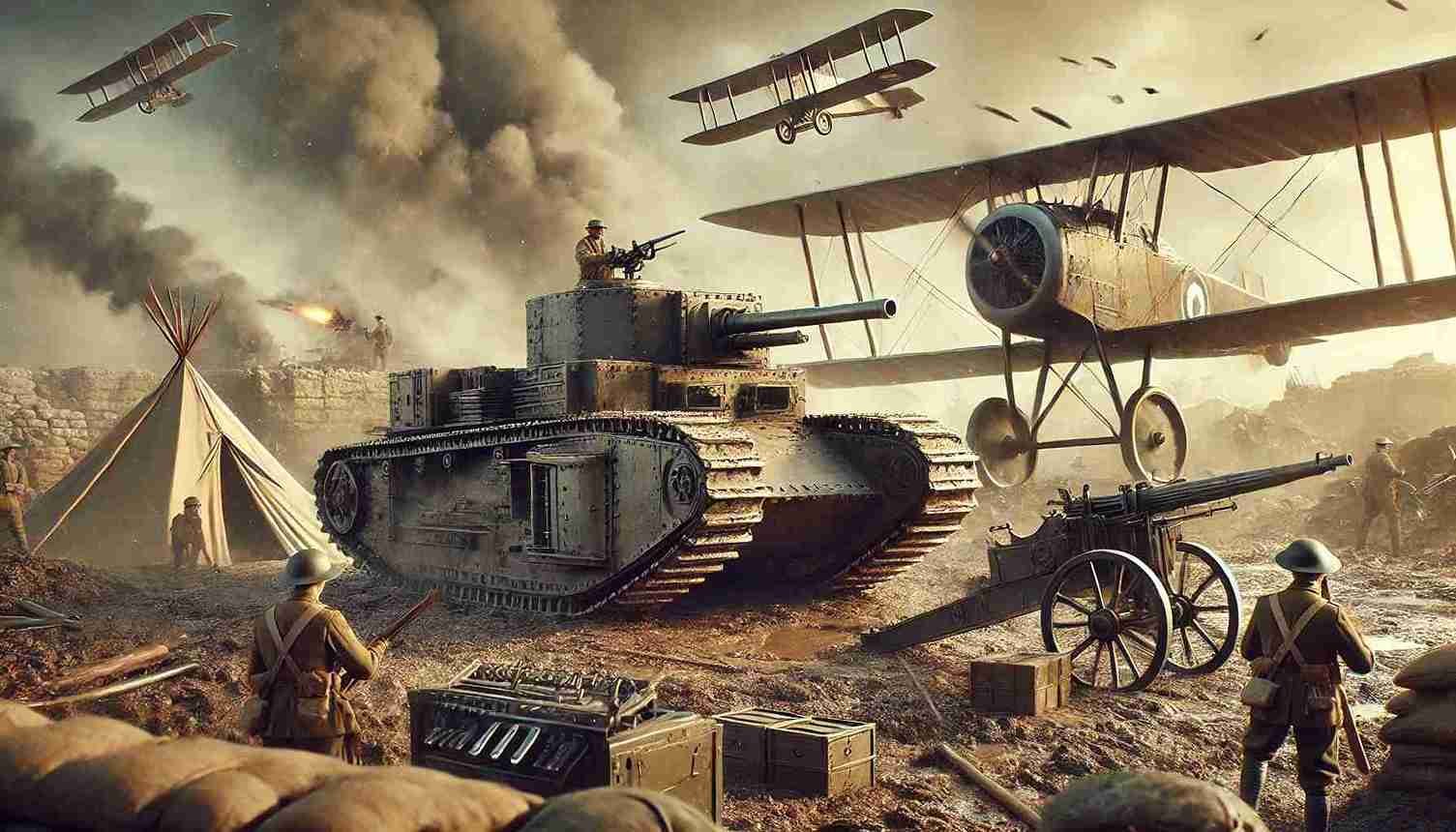
Brief Story of World War 1 at a Glance
Discover the causes, key events, and lasting impact of World War I, the global conflict from 1914 to 1918 that reshaped nations and modern history.
- December 3, 2024
- 12:45 am
World War 1
World War 1, often called the Great War, began in 1914 and lasted until 1918, reshaping global politics, societies, and economies. What started as a localized conflict spiraled into a global catastrophe involving over 30 nations. The war’s origins were deeply rooted in a volatile mix of alliances, militarism, imperialism, and nationalism, with far-reaching consequences that shaped the modern world. This detailed account explores the causes of World War 1, major incidents, key battles, and its lasting legacy.
The Pre-War Climate: A Tense Europe
The early 20th century saw Europe brimming with tensions. Empires were expanding, nations were arming themselves, and alliances were being forged to prepare for potential conflicts. Countries like Britain, Germany, France, and Russia were in constant competition for economic and military superiority.
The Role of Militarism
Militarism played a central role in creating an atmosphere of inevitable conflict. In an arms race, European nations, especially Germany and Britain, accumulated weaponry and amassed sizable armies. Germany’s ambition to build a navy rivaling Britain’s Royal Navy heightened fears of war.
Imperialism and Rivalries
Tensions between European countries grew as a result of the desire for colonies. Africa, Asia, and the Pacific were battlegrounds for imperial domination, creating tensions, particularly between Britain, France, and Germany.
Nationalism and Ethnic Tensions
Nationalism stoked rivalries within and between countries. Internal conflict resulted from nationalist groups seeking independence in multiethnic empires such as the Ottoman Empire and Austria-Hungary.

Fig: Depiction of the signing of the Treaty of Versailles in 1919(Generated Art)
The Spark: Archduke Franz Ferdinand's Assassination
The killing of Austria-Hungary’s Archduke Franz Ferdinand and his wife Sophie in Sarajevo on June 28, 1914, was the direct cause of World War 1. Gavrilo Princip, a member of a Serbian nationalist group, carried out the attack, hoping to inspire independence for Slavic nations under Austro-Hungarian rule.
With Germany’s help, Austria-Hungary gave Serbia a deadline. Austria-Hungary declared war on Serbia on July 28, 1914, because Serbia did not live up to their expectations. The world became embroiled in battle as a result of the alliances that were sparked by this incident.

Fig: The Spark Archduke Franz Ferdinand’s Assassination (Generated Art)
Learn More About Microplastic Pollution Solutions: Revolutionizing Clean Ocean
Galaxies Mystery
Galaxies are among the universe’s most mysterious and awe-inspiring structures, home to billions of stars, planets, and other celestial objects. One of the greatest enigmas is the presence of dark matter, an invisible substance that holds galaxies together through its gravitational pull. Within their cores, supermassive black holes lurk, consuming matter and emitting powerful jets of energy, shaping the galaxy’s evolution. Some galaxies defy explanation, such as those with almost no dark matter or stars moving at unimaginable speeds. Others, like quasars, shine with incredible luminosity, powered by ancient black holes. Galaxies are not only cosmic wonders but also hold the secrets to understanding the universe’s past, present, and future.
The Road to Global Conflict: The Domino Effect
The war quickly escalated due to entangled alliances:
Two days after declaring war on Russia on August 1, 1914, Germany declared war on France and backed Austria-Hungary. After Germany violated its neutrality by invading Belgium, Britain joined the war. Japan joined the Allies to annex German possessions in the Pacific. The Ottoman Kingdom opened up new fronts in the Middle East by embracing the Central Powers.

Fig: Early 20th-century military parade with a vintage car in the foreground.(Generated Art)
Early Battles and Stalemates
The Schlieffen Plan and the Western Front
In order to swiftly defeat France, Germany’s Schlieffen Plan called for an invasion of Belgium before moving east to face Russia. However, the plan faltered at the First Battle of the Marne in September 1914, where Allied forces halted the German advance. The Western Front descended into trench warfare, with neither side gaining significant ground.
The Eastern Front
On the Eastern Front, Germany and Austria-Hungary posed a threat to Russia. Early victories like the Battle of Tannenberg showcased Germany’s military prowess, but the vast Russian forces kept the Central Powers engaged.
Naval Warfare and Blockades
At sea, Britain’s naval blockade of Germany aimed to cripple its economy, while German U-boats targeted Allied shipping. The sinking of the Lusitania in 1915, a British passenger liner with American citizens aboard, brought the U.S. closer to joining the war.

The Global Scope of the War
World War 1 extended far beyond Europe:
- In Africa: European powers fought over colonies, involving African soldiers in campaigns.
- In the Middle East: The Ottoman Empire battled the Allies in campaigns like Gallipoli and Mesopotamia.
- In Asia and the Pacific: Japan’s conquest of German lands in Asia and the Pacific improved its standing in the area.
The war’s global reach highlighted its unprecedented scale and the interconnectedness of the world.
The War Intensifies: Major Incidents
The Battle of Verdun (1916)
The nearly year-long Battle of Verdun came to represent French resistance. It was a prime example of trench warfare’s atrocities, with over 700,000 casualties.
The Battle of the Somme (1916)
The Allies attacked the Somme in an effort to relieve pressure on Verdun. The battle saw over one million casualties and introduced tanks, though with limited success.
Chemical Warfare
The use of poison gas, such as chlorine and mustard gas, added a terrifying dimension to the war. Soldiers faced horrific injuries and death, leading to international condemnation.
The Entry of the United States (1917)
Germany’s unrestricted submarine warfare and the Zimmermann Telegram, which proposed a German-Mexican alliance, prompted the U.S. to join the Allies. By providing desperately needed manpower and resources, American forces boosted Allied morale.

The Endgame: The Fall of Empires
By 1918, the Central Powers were exhausted. Germany’s final offensive, the Spring Offensive, initially succeeded but ultimately failed due to logistical issues and Allied counterattacks during the Hundred Days Offensive.
The Armistice
The signing of an armistice on November 11, 1918, marked the end of the war. Over 16 million people had died and millions more had been injured in the conflict.
The Aftermath and Treaty of Versailles
Germany was subject to severe sanctions under the 1919 Treaty of Versailles, which included reparations, military limitations, and territorial losses. While intended to secure peace, it sowed the seeds of World War 2 by fostering resentment in Germany.
- The Collapse of Empires
The Austro-Hungarian, Ottoman, German, and Russian Empires dissolved, leading to new nations like Poland, Czechoslovakia, and Yugoslavia.
The Middle East was divided into mandates under British and French control, shaping its future conflicts. - Social and Economic Consequences
Economies across Europe were devastated, leading to inflation and unemployment.
Women, having taken on new roles during the war, gained momentum in their fight for suffrage and equality.
Conclusion: The Lessons of World War 1
World War 1 was a cataclysmic event that reshaped the 20th century. Its causes, battles, and consequences offer important lessons about the dangers of unchecked militarism, nationalism, and alliances. While the war was meant to be “the war to end all wars,” its unresolved tensions led to even greater conflicts.

















I’ve recently started a website, the info you provide on this web site has helped me tremendously. Thank you for all of your time & work.